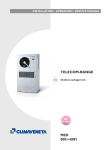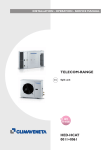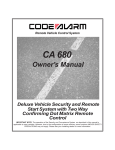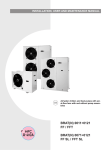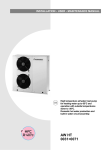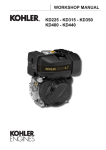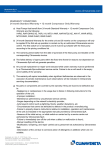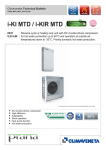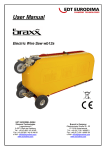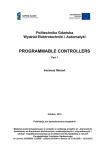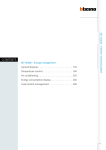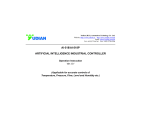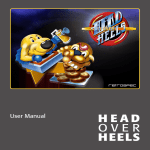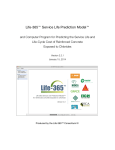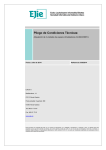Download TELECOM INVERTER DC RANGE i-MED 0031-0051-0071
Transcript
INSTALLATION - OPERATION - SERVICE MANUAL TELECOM INVERTER DC RANGE EN Outdoor packaged unit i-MED 0031-0051-0071 INDEX General warnings 3 Menu structure 17 Fundamental safety rules 3 Display screen 20 Identification 4 “LAN” Local Network 35 Receiving and handling the product 4 Interconnection between the units by shielded cable 36 Description of the appliance 5 Setting the addresses of the units (from 1 to 10) and the user terminals (from 11 to 20) 36 38 Main functions 6 Operating Modes 6 Configuring the software for the recognition and management of the units Dimensional drawings 7 Special functions of the LAN network 39 General technical data 13 Serial board supervisory system 43 Operating limits 13 Alarm (Troubleshooting) 44 Installation 13 Troubleshooting 46 Electrical connections 14 Operating characteristics 47 Extended shutdown 47 Routine maintenance 47 Special maintenance 48 Disposal 48 Condensate drain 48 ELECTRICAL WIRING DIAGRAM ON THE MACHINE Control diagram Controller 15 16 Liability disclaimer This bulletin refers to standard executions, particularly as regards dimensions, weight, electric, hydraulic, aeraulic and refrigerant connections (where applicable). Contact Climaveneta Commercial Office for further drawings and schemes. Climaveneta declines any liability deriving from use of the bulletin. This bulletin is the exclusive property of Climaveneta and all forms of copy are prohibited. The data contained herein are subject to change without notice. In some parts of this manual, the following symbols are used: WARNING = for actions that require special care and suitable preparation PROHIBITED = for actions that absolutely MUST 2 i-MED EN Specialist personnel (electrician) Person with in-depth knowledge and experience such as to be able to recognise risks and avoid dangers that may derive from electricity (IEV 826-09-01). GENERAL WARNINGS Incorrect installation, control and maintenance, improper use or installation by unqualified personnel absolves the manufacturer from all liability, whether contractual or otherwise, for damage to people, animals or things. Only those applications specifically indicated in this list are permitted. Read this manual carefully. All work must be carried out by qualified personnel in conformity with legislation in force in the country concerned. The warranty is void if the above instructions are not respected and if the unit is started up for the first time without the presence of personnel authorised by the Company (where specified in the supply contract) who should draw up a “start-up report”. The documentation supplied with the unit must be consigned to the owner who should keep it carefully for future consultation. When the items are consigned by the carrier, check that the packaging and the unit are undamaged. If damage, missing components or consignment errors are noted, indicate this on the delivery note. A formal complaint should be sent via fax or registered post to the After Sales Service within eight days from the date of receipt of the items. All the operations involved in handling, installing, starting up and testing the unit must be carried out by qualified personnel. Failure to observe this warning could cause serious damage. This appliance contains R410A refrigerant gas: at the end of its working life, it should be taken to a special collection centre; care should be taken to avoid damage to the gas circuit and the finned coil. Too low temperatures are harmful to health and a useless waste of energy. Avoid direct contact with the air flow for prolonged periods. These appliances have been designed for cooling and must be used for this purpose in applications compatible with their performance characteristics. FUNDAMENTAL SAFETY RULES When operating equipment involving the use of electricity and refrigerant gas, a number of fundamental safety rules must be observed, namely: The unit must not be used by children or by unfit persons without suitable supervision. Do not touch the unit with bare feet or with wet or damp parts of the body. Do not carry out cleaning operations without first disconnecting the unit from the electricity supply by placing the mains switch in the “off” position. Do not modify safety or control devices without authorisation and instructions from the manufacturer. Do not pull, detach or twist the electrical cables coming from the unit, even when disconnected from the mains electricity supply. Do not open doors or panels providing access to the internal parts of the unit. Do not dispose of, abandon or leave within reach of children packaging materials (cardboard, staples, plastic bags, etc) as they may represent a hazard. Do not allow refrigerant gas to leak into the atmosphere. Avoid contact with the refrigerant gas as it is potentially hazardous. Do not sit or stand on the appliance and/or rest any type of object on top of it. Do not spray or throw water directly on the appliance. Do not introduce pointed objects through the air intake grills. Respect safety distances between the unit and other equipment or structures. Guarantee adequate space for access to the unit for maintenance and/or service operations.. Power supply: the cross section of the electrical cables must be adequate for the power of the unit and the power supply voltage must correspond with the value indicated on the respective units. All units must be earthed in conformity with legislation in force in the country concerned. Electrical connections should be carried out as indicated in the instructions to guarantee correct operation of the unit. Handle the unit with the utmost care to avoid damage. EN i-MED 3 IDENTIFICATION The direct expansion units cab be identified by the: Packaging label Giving the data identifying the product. Rating plate Giving the technical and performance data of the unit. If this is lost, ask the After Sales Service for a replacement. The rating plate is fixed in a panel inside the electric board Tampering with or the removal or absence of rating plates or other means enabling the unit to be identified causes problems during installation and maintenance. RECEIVING AND HANDLING THE PRODUCT The direct expansion units are supplied accompanied by: - instruction manual. - warranty certificate. - CE declaration. These are contained in a plastic bag attached to the top of the unit. The instruction manual is an integral part of the unit and should therefore be read and kept carefully. Do not dispose of packaging materials in the environment or leave them within reach of children as they may represent a hazard/source of pollution. The unit should always be handled by qualified personnel using equipment adequate for the weight of the unit. 4 i-MED EN MED Inverter DESCRIPTION OF THE APPLIANCE The i-MED Inverter packaged units are suitable for the precision air-conditioning of mobile telephone shelters. Direct expansion version, with inverter compressor, for R410A. They are designed for indoor installation and fitted with a freecooling damper to allow energy savings. STRUCTURE Panelling, base and internal structure made from epoxycoated metal, with stainless steel condensate collection pan. The cover panels are internally coated with a thermal and acoustic insulation, closed cell polyethylene foam extinguishing. INVERTER COMPRESSORS A hermetic compressor rotary scroll or DC. Brushless according to the size and full of the thermal protection at high efficiency with control by INVERTERS electronic capabilities. This allows a good capacity with a partial loads, which represent over 75% of normal operation time allowing an effective saving average total energy which can lead to 50% compared to conventional technology type ON / OFF. Fitted on rubber antivibration mounts and complete charge of oil and oil separator to contain the effects of migration of gas charge and of the absence of lubrication Crankcase. POWER AND CONTROL ELECTRICAL PANEL Power and control electrical panel constructed in accordance with IEC 204-1/EN60204-1, complete with compressor contactor and thermal solenoid switch and door lock safety device. AIR FILTERS Filter Removable and washable made of acrylic material self-extinguishing with efficiency class EU3 (standard) or higher EU4. EXCHANGE BATTERIES Made using copper tubes and aluminium fins with a high exchange surface area. EVAPORATOR FAN Radial fan with standard AC power supply or in alternative 48VDC power supply with electronic speed control. CONDENSER FAN Axial fans, statically and dynamically balanced. Four or Six - pole electric motor with built-in thermal cutout. Housed in aerodynamic tubes with accident prevention grill. Device for operation according to the outside air temperature: continuous fan rotation speed control via pressure transducer. REFRIGERANT CIRCUIT Refrigerant circuit featuring the following components: thermostatic valve, dewatering filter, liquid indicator, liquid receiver, pressure switches for controlling the discharge and suction pressure. Unit supplied complete with refrigerant charge, factory tested. ELECTRIC HEATERS Electric heater,s with double safety feature. Heating capacity 1,7 or 3,4 kW, depending on the size selected. DIFFERENTIAL PRESSURE SWITCHES Two differential air pressure switches for detecting faults with the indoor fan or blocked filters. PLC The operation of the unit is managed by a PLC with a graphic display. OPTIONAL ACCESSORIES TO BE REQUESTED WHEN ORDERING - Humidity Sensor - Function Dehumidification - Clock Card - Serial adapter for interfacing with external BMS - Soundproof compressor jacket - Shutter management and free cooling - Air filter EU4 instead EU3 standard - Air filter for fresh air intake - Electric heater - Power supply from UPS 48 VDC for evaporator fan and damper free cooling if req. For any further request please contact the office. EN i-MED 5 MAIN FUNCTIONS Main features • Modulation of capacity Using the new DC INVERTER SCROLL technology currently implemented in technological applications. The operation of the units is consequently automatically adapted to the actual load conditions on site, providing the exact amount of cooling required to maintain stable conditions by modulating the capacity. This also allows the units to be used in sites with varying thermal loads. • New R410A refrigerant The use of the new high performance R410A refrigerant with low atmospheric impact is in line with the strictest environmental protection parameters. • Modulation of the conditioned air flow-rate The use of new high efficiency INVERTER EC technology on the evaporator fan means that the i-MED can operate at between 50% and 100% of the air flow-rate in freecooling operation, so as to minimise the power consumption of the fan. OPERATING MODES Operation in freecooling or emergency mode Operation in mechanical cooling mode Outdoors air Condenser air flow Ricirculation air Outdoors air (Free Cooling) Evaporator air flow 6 i-MED EN Evaporator air flow 88,5 EN i-MED 7 914 727 TOP VIEW 900 976 88,5 11 108 500 = 11 103,5 434 1698 1706 CONDENSATE DRAIN OUTPUT 875 BOTTOM VIEW 494 409 40 113,5 168,5 65 = = ELECTRICAL POWER SUPPLY INPUT 730 500 939 77,5 = 500 N°10 SLOTS Ø8,5x20 500 1720 500 115 270 649 1735 744 215 31,5 40 420 39,5 REMOVABLE PANEL REMOVABLE PANEL REMOVABLE PANEL DIMENSIONAL DRAWINGS i-MED 0031 UNDER DIMENSIONAL DRAWINGS i-MED 0031 UNDER - WALL DRILLING PATTERN 258 362 120 270 258 115 350 115 2400 * 270 1735 816 197 * 80 * VIEW FROM INSIDE THE SHELTER 760 62,5 80 * 153,5 468 * 497 * 29 30 40 * = HIPOTESIZED 8 i-MED EN 744 EN i-MED 495 600 11 124 128 42,5 605,5 1185,5 CONDENSATE DRAIN OUTPUT 915 BOTTOM VIEW REMOVABLE PANEL 90,5 11 510 49 1935 606 236 = 258 871,5 TOP VIEW 1016 939 N°10 SLOTS Ø8,5x20 500 979 258 = 18,5 15 155 550 550 550 115 24 114 19 649 1185,5 843 114 599 273 75,5 208,5 40 40 730 ELECTRICAL POWER SUPPLY INPUT 270 824 200 77,5 49 18,5 DIMENSIONAL DRAWINGS i-MED 0051 UNDER 9 1896 1906 1° DIMENSIONAL DRAWINGS i-MED 0051 UNDER - WALL DRILLING PATTERN 760 62,5 258 206 235 * 120 17 * = HIPOTESIZED 10 i-MED EN 80 * 1095 * 315 * 270 45 522 258 2400 * 270 1970 195 * 193,5 80 * VIEW FROM INSIDE THE SHELTER 744 EN i-MED 75 128 OUTPUT DRAIN CONDENSATE 1095 BOTTOM VIEW 188 685 1466 31,5 11 125,5 298 483,5 945 1196 TOP VIEW 1119,4 600 1159 298 500 18,5 500 125,5 19 208 200,5 128 REMOVABLE PANEL 2237 35 1° 778 795 ELECTRICAL POWER SUPPLY INPUT N°12 SLOTS Ø8,5x20 200,5 300 1005 18,5 1866 785,7 71,7 1340 11 24 2 680 49 2279 238 500 500 163,5 2264 43 170 857,4 35 329 692,5 1462 1023 250 50 REMOVABLE PANEL DIMENSIONAL DRAWINGS i-MED 0071 UNDER 11 DIMENSIONAL DRAWINGS i-MED 0071 UNDER - WALL DRILLING PATTERN VIEW FROM INSIDE THE SHELTER 285 2279 +5 0 285 300 * = HIPOTESIZED 12 i-MED EN 80 * 15 80 113 * 165 0 -5 * 255 +5 0 80 1115 665 300 80 * 198 2400 * 800 8 * 198 775 GENERAL TECHNICAL DATA Model N. Circuit(s) / N. Compressor(s) Refrigerant Power supply V/Ph/Hz COOLING CAPACITY Total cooling capacity Sensible cooling capacity SHR Compressor(s) power input Evaporator air flow Free-cooling air flow Evaporator fan 48 V DC power input Evaporator fan AC power input Condenser max. air flow Condenser fan AC power input Sound pressure level (r=1m, Q=2) ELECTRIC HEATER Total heating capacity DIMENSIONS & WEIGHT (1) (1) (1) (1) OVER UNDER OVER UNDER OVER UNDER OVER UNDER Width Depth (2) Height Net weight kW mc/h mc/h kW kW mc/h kW dB(A) 0031 1/1 R410A 230/1/50 MAX MIN 9,53 4,34 7,22 4,34 0,76 1,00 2,37 0,75 1600 800 1600 800 0,36 0,11 0,23 0,17 2500 2500 0,16 0,16 52 0051 1/1 R410A 230/1/50 MAX MIN 12,56 4,92 10,97 4,92 0,87 1,00 3,18 0,78 3200 1600 3200 1600 0,54 0,16 0,49 0,37 4000 4000 0,75 0,75 54 0071 1/1 R410A 400/3N/50 MAX MIN 17,6 7,96 15,45 7,96 0,88 1,00 4,49 1,18 3900 1950 3900 1950 1,08 0,17 0,98 0,74 5900 5900 0,41 0,41 62 kW 1,7 3,4 3,4 mm mm mm mm mm mm kg kg n.a. 976 n.a. 500 (745) n.a. 1735 n.a. 175 n.a. 1016 n.a. 600 (840) n.a. 1935 n.a. 230 n.a. 1196 n.a. 780 (1025) n.a. 2280 n.a. 310 kW kW (1) Ref. Conditions: Indoor=27°C, 45%UR Outdoor=35°C (2) The dimension between ( ) considers rain hood dimension OPERATING LIMITS COOLING Max Min DB: Dry bulb Inside temp. DB/WB °C. 32/23,5 22/15,5 Outside temp. DB/WB °C 48/-25/- WB: wet bulb CALIBRATION OF PROTECTION DEVICES High pressure switch Low pressure switch Opens (bar) 41,5 (+0-1,4) 3 (+-0,2) Closed (bar) 33(+-2) 3,9 (+-0,3) Reset automatic automatic INSTALLATION CHOICE OF INSTALLATION SITE Before installing the unit, agree with the customer the site where it will be installed, taking the following points into consideration: - check that the fixing points are adequate to support the weight of the unit; - pay scrupulous respect to safety distances between the unit and other equipment or structures (see functional clearances); - install the unit with a minimum slope of 2 mm/m to guarantee condensate drainage POSITIONING Before handling the unit, check the capacity of the lift equipment used, respecting the instructions on the packaging. To move the unit horizontally, make appropriate use of lift trucks or similar, in the most appropriate way. The units are supplied with the following accessories to simplify installation: vibration dampers, washers and fastening bolts for the 6 slots on the indoor unit. The distance between the fastening points on the ceiling are shown in the dimensioned drawings on page 8. CONDENSATE DRAIN CONNECTION This operation must be carried out with particular care. The unit is fitted with a condensate drain pan, and the connector on the rear of the unit is supplied with a plastic hose. The following warnings must be observed for the connections: 1. Do not connect the drains from different units together. 2. Make sure the drain pipe has a slope of at least 2 cm/m without obstructions or bottlenecks. 3. Fit a drain trap at least 30 mm below of the condensate pan. 4. Connect the condensate drain pipe to a rainwater drainage system. Do not connect to the sewage system as odours may be sucked up if the water in the drain trap evaporates. 5. After connecting, check correct drainage of the condensate by pouring water into the pan. 6. Fill the drain trap with water in the tray by pouring water into the pan. EN i-MED 13 ELECTRICAL CONNECTIONS Voltage must be within a tolerance of ±10% of the rated power supply voltage for the unit.. If these parameters are not respected, contact the electricity supply company. For electrical connections, use double insulation cable in conformity with current legislation in the country concerned. Install, if possible near the unit, an appropriate protection device to isolate the unit from the mains supply. This should have a delayed characteristic curve, contact opening of at least 3 mm and an adequate interruption and differential protection capacity. If this device is not visible from the electrical panel of the unit, it should be lockable An efficient earth connection is obligatory. Failure to earth the appliance absolves the manufacturer of all liability for damage. In the case of three phase units, ensure the phases are connected correctly. Do not use refrigerant pipes to earth the unit. ra dell’apparecchio. (Used the dedicated clamps) The condensing units leave the factory fully wired. Installation is limited to connection to the mains electrical supply and connection of the remote (ON/OFF) switch, operations that must be carried out by qualified personnel in compliance with current legislation. For all electrical work, refer to the electrical wiring diagrams in this manual. You are also recommended to check that: - The characteristics of the mains electricity supply are adequate for the power values indicated in the electrical characteristics table below, also bearing in mind the possible use of other equipment at the same time. Power to the unit must be turned on only after installation work (refrigerant and electrical) has been completed. All electrical connections must be carried out by qualified personnel in accordance with legislation in force in the country concerned. Respect instructions for connecting phase, neutral, earth conductors and the 48VDC polarities. The power line should be fitted upstream with a suitable device to protect against short-circuits and leakage to earth, isolating the installation from other equipment. ELECTRICAL PANEL The electrical panel is located inside the unit at the top of the technical compartment where the various components of the refrigerant circuit are also to be found. To access the electrical panel, remove the front panel of the unit by undoing the self-tapping screws. To access the components in the electrical panel and the terminal boards, undo the four screws on the panel itself. ELECTRICAL WIRING DIAGRAM ON THE MACHINE Only for the machines with 48VDC power supply: Must protect the 48 VDC power supply with a bipolar thermal Overload switch. ( The negative and even the positive) POWER INPUT OF THE INDIVIDUAL COMPONENTS COMPRESSOR R410A Model 0031 0051 0071 Power input V/Ph/Hz 230/1/50 230/1/50 400/3N/50 EVAPORATOR FAN EVAPORATOR FAN AC power input 48 V DC power input F.L.I. F.L.A. L.R.A. Nr. kW A A 5,6 17,2 2,7 1 5,6 17,2 2,7 1 10,1 15,4 5,3 2 F.L.I. kW 0,2 0,5 1,0 F.L.A. A 1,0 2,4 4,7 TOTAL UNIT POWER INPUT i-MED R410A COOLING ONLY, COOLING ONLY, with EVAPORATOR with EVAPORAFAN AC power input TOR FAN AC and ELECTRIC power input HEATER Power input F.L.I. F.L.A. S.A F.L.I. F.L.A. Model V/Ph/Hz kW A A kW A 0031 230/1/50 6,0 18,9 4,4 1,9 8,4 0051 230/1/50 6,8 23,0 8,5 3,9 17,2 0071 400/3N/50 11,5 21,9 11,8 4,4 19,5 14 i-MED EN Nr. 1 1 2 F.L.I. kW 0,4 0,5 1,1 F.L.A. A 6,2 9,8 19,5 CONDENSER FAN Nr. 1 1 1 F.L.I. kW 0,2 0,8 0,4 F.L.A. A 0,7 3,4 1,8 ELECTRIC HEATER Nr. 1 2 2 F.L.I. kW 1,7 3,4 3,4 F.L.A. A 7,4 14,8 14,8 COOLING ONLY, 48V DC POWER SUPCOOLING ONLY, with EVAPORATOR PLY (EVAP. FAN + with EVAPORATOR FAN 48 V DC FREE COOLING FAN 48V DC power input and DAMPER + ELECTRIC power input ELECTRIC HEATER BOARD) F.L.I. F.L.A. S.A F.L.I. F.L.A. F.L.I. F.L.A. kW A A kW A kW A 5,8 17,9 3,4 1,7 7,4 0,4 6,6 6,4 20,6 6,1 3,4 14,8 0,6 10,2 10,5 17,2 7,1 3,4 14,8 1,1 19,9 band band compressor band heater band compressor support unit band band free cooling support unit band fan. support unit free cooling fan heater. support unit low temperature alarm band max temperature alarm band high temperature alarm CONTROL DIAGRAM EN i-MED 15 CONTROLLER Select alarms Display Programming Up / Down Exit Confirm Room T: Display The display shows the main values managed by the unit. Alarms Alarms are signalled by the light on the alarm button. Pressing the button displays the details of the causes of alarm. To reset the alarms, press the alarm button again. The controller saves up to 100 alarms. Displaying and setting the unit parameters Pressing the Prg button and entering the password accesses the menu for setting the parameters. The operating parameters are sub-divided into the following levels: • Level 1 (incorrect PSW): general unit status, alarms and graphs. • Level 2 (user PSW required): USER MENU (0000). • Level 3 (maintenance PSW required): MAINTENANCE MENU. 16 i-MED EN DESCRIPTION OF THE AREAS SHOWN ON THE DISPLAY FIRST PAGE Menu structure: the pages in the main loop are scrolled using the UP and DOWN buttons. If the clock is fitted and operating, the time and date are displayed. If an analogue input is configured as the room temperature, this is displayed. If an analogue input is configured as the room humidity, this is displayed. AREA1: this displays the general status of the unit. Unit off Unit on and fan off Unit on and fan on Unit on and air-conditioner 1 fan active Unit on and air-conditioner 2 fan active Unit on and air-conditioner 1 and 2 fan active AREA 2: this displays the detailed status of the unit. Active alarm Maintenance signal Unit off from time bands Unit off from keypad Unit off from digital input Unit off from time bands Unit off from supervisor Confort function active Suction pressure limit at compressor start Suction - discharge delta P at compressor start. Free cooling disabled by digital input Unit in emergency mode Unit in night mode Unit on in LAN due to high room temperature Unit on in LAN due to low room temperature Unit awaiting LAN Unit on in LAN AREA 3: this displays an icon that, in the event of an alarm or a maintenance signal, indicates the type of alarm or the device that requires maintenance respectively. Configuration alarm Fire/smoke/flood alarm Fire/smoke alarm Flood alarm Outlet fan flow alarm Outlet fan thermal overload alarm Blackout /incorrect phase sequence alarm Suction - discharge delta P limit alarm Envelope alarm (operation outside the zone) Thermostatic valve EEPROM driver alarm Inconsistent envelope alarm Thermostatic valve not closed at all Thermostatic valve driver temperature probe broken or not connected Low pressure alarm Thermostatic valve driver pressure probe broken or not connected Compressor alarm on air-conditioner 1 and 2 Inverter alarm tLAN driver thermostatic valve alarm Thermostatic valve motor alarm High pressure alarm from digital input/analogue input Compressor alarm on air-conditioner 2 EN i-MED 17 Compressor alarm on air-conditioner 1 Condenser fan thermal overload alarm Heater alarm Blocked filter alarm Damper alarm EPROM alarm Room temperature probe alarm Outside temperature probe alarm Outlet temperature probe alarm Maximum room temperature alarm Condensing pressure probe alarm High room temperature alarm High room humidity alarm Low room humidity alarm Room thermostat alarm Auxiliary alarm Clock alarm Compressor maintenance Outlet fan maintenance Condenser fan maintenance Compressor maintenance, air-conditioner 1 and 2 Compressor maintenance, air-conditioner 2 Compressor maintenance, air-conditioner 1 Outlet fan maintenance air-conditioner 1 and 2 Outlet fan maintenance, air-conditioner 2 Outlet fan maintenance, air-conditioner 1 Room humidity probe alarm LAN disconnected alarm Low room temperature alarm AREA 4: this displays the unit operating mode, heating or cooling, if the outlet fan temperature control function is enabled. Unit in cooling mode Unit in heating mode Fan temperature control not active AREA 5: all the devices currently operating are displayed. Compressor active Air-conditioner 1 compressor active Air-conditioner 2 compressor active Air-conditioner 1 and 2 compressor active Inverter-driven compressor with current activation ramp AREA 6: all the devices currently operating are displayed. Heater active Air-conditioner 1 heater active Air-conditioner 2 heater active. Air-conditioner 1 and 2 heaters active AREA 7: all the devices currently operating are displayed. Dehumidification active Emergency fan active AREA 8: this displays the Unit LAN address. Unit LAN address AREA 9: if the ON/OFF from keypad option is enabled, this displays the corresponding icon. Press ENTER for 5 seconds to switch the unit off 18 i-MED EN Press ENTER for 5 seconds to switch the unit on AREA 10: this displays the layout of the unit. Packaged unit without freecooling Packaged unit with freecooling closed, inside air recirculation Packaged unit with freecooling open, full outside air Split unit without freecooling Split unit with freecooling 50%, inside/outside air mixture Split unit with freecooling open, full outside air Packaged unit with freecooling 50%, inside/outside air mixture Split unit with freecooling closed, inside air recirculation SECOND PAGE This displays the values of the analogue inputs enabled, identified by icons. Room air temperature Outlet air temperature Room air humidity Condensing pressure Outside air temperature THIRD PAGE This shows the set point and band for all the devices enabled, identified by icons. Outlet fan temperature control in cooling Outlet fan temperature control in heating Freecooling Compressor Heaters Dehumidification Compressor 1 Compressor 2 Heater 1 Heater 2 Emergency fan FOURTH PAGE This shows information relating to the software and hardware. NOTE: the pages of the main loop is run with the UP or DOWN button MANAGEMENT ELECTRONIC THERMOSTATIC VALVE With thermostatic valve enabled displays a summary screen in the main loop: Close to the suction temperature value, in the case of high suction temperature protection, it appears an upwards flashing arrow. In the bottom of the screen is displayed in case of alarm a concise description: LOP protection MOP protection Error Temp Sensor Error Sensor Press. Step Motor Error EEPROM error Valve Not Closed DRIVER NOT CONNECTED EN i-MED 19 DISPLAY SCREENS MAIN LOOP FIRST PAGE Press the sequence. button displays the following status screens in SECOND PAGE THIRD PAGE 1 unit controlled by the electrical panel controller 2 units controlled by the electrical panel controller FOURTH PAGE Press the menu. 20 i-MED EN button repeatedly to return to the main PASSWORD ENTRY Secondary loop Pressing the button accesses the password entry page. Depending on the password entered, 3 loops of screens may be enabled: level 0 - incorrect password; level 1 - user password 0000 (modifiable); level 2 - maintenance password (modifiable); Main screen Press together for 5 seconds The language can be changed Press the Prg button User password 0000 (modifiable) LEVEL 1 Password not correct LEVEL 0 Displays only: Displays: Maintenance password Contact Climaveneta LEVEL 2 Displays: A Status Digital 1 Digital 0 Analogue I Analogue 0 Operating hours pLAN network A Stati B Alarm log B Alarm log B Alarm log C Graphs C Graphs C Graphs D Clock D Clock E User E User Digital 1 Digital 0 Analogue I Analogue 0 Operating hours pLAN network Fan Freecooling Compressor Heater Dehumidification Alarms pLAN network Set password A Status Digital 1 Digital 0 Analogue I Analogue 0 Operating hours pLAN network Fan Freecooling Compressor Heater Dehumidification Alarms pLAN network Set password F Maintenance Analogue I Operating hours Manual alarms Password EN i-MED 21 LEVEL 0 A ALARM LOG Digital 1 Digital O Analogue 1 Analogue O Operating Hours pLAN The inputs are already configured during production of the unit. Before changing any settings, contact the office. Digital I STATUS Digital I Digital O Analogue I Analogue O Operating hours pLAN DIGITAL O i-MED EN To move to the next row press . Screen displaying the status of the digital inputs Screen displaying the status of the digital outputs Screen displaying the status of the analogue inputs Screen displaying the status of the analogue outputs Screen displaying the device operating hours Screen displaying the status of the pLAN network Description Not used Room thermostat External alarm Fire/smoke alarm Flood alarm Flood and fire/smoke alarm Remote ON/OFF Remote ON impulse Remote OFF impulse Enable freecooling Confort function Low pressure switch High pressure switch Outlet fan thermal overload Condenser fan thermal overload Heater thermal overload Outlet fan flow Outlet fan filters blocked 230/400Vac power connected and incorrect phase sequence Air-conditioner 1 alarm Air-conditioner 2 alarm Air-conditioner 1 compressor on Air-conditioner 2 compressor on Inverter allarm Possible configurations of the digital outputs Value 0 1 2 3 4 5 6 7 8 9 10 11 12 13 14 15 16 17 18 19 20 21 22 23 24 25 26 27 28 A2 Confirm by pressing . Possible configurations of the digital inputs Value 0 1 2 3 4 5 6 7 8 9 10 11 12 13 14 15 16 17 18 19 20 21 22 23 A1 22 To change the To change the value press . value press and . Description Not used allarm 1 allarm 2 allarm 3 allarm 4 allarm 5 allarm 6 allarm 7 FC fan Unit status Compressor status Fan discharge status FC status Heater status FC fan status FC open FC closed Discharge fan Condenser fan Compressor Dehumidification Heater Fan discharge 1 Fan discharge 2 Compressor 1 Compressor 2 Heater 1 Heater 2 Inv. Compressor ANALOGUE I Pressure Humidity Room T. Outlet T. Outside T. A3 ANALOGUE O Open FC Outlet fan Cond. fan Free cooling fan A4 Operating hours A5 This screen is displayed in systems with: 1 unit controlled by one PLC A6 This screen is displayed in systems with: 2 units controlled by the same PLC A7 This screen is displayed in systems with: 2 units controlled by the same PLC pLAN network A8 pLAN network status screen This screen, only active if the LAN is enabled, displays the status of the units connected in the pLAN network. Addresses 1 to 10 are used for controllers, addresses 11 to 20 for private terminals, and address 32 for the shared terminal. EN i-MED 23 B ALARM LOG List of alarms ALARM LOG screen In this screen this displays the alarm log. A maximum of 100 events can be saved, once having reached the one hundredth alarm, i.e. the last space available in the memory, the next alarm is saved over the oldest alarm (001), which is deleted, and so on for subsequent. To scroll the list of logged alarms press / . Reset memory AC 1 fan hour threshold AC 2 fan hour threshold AC 1 comp. hour threshold AC 2 comp. hour threshold Fan hour threshold Compressor hour threshold Clock Auxiliary Room thermostat Low humidity High humidity Low temperature High temperature Maximum temperature pLAN network Pressure probe Humidity probe Outlet temp. probe Outside temp. probe Room temp. probe EPROM Freecooling damper Dirty filters Heater thermal overload Fan thermal overload AC 1 compressor AC 2 compressor Low pressure High pressure A (Analogue) High pressure D (Digital) No power Fan thermal overload No flow Flood Fire/smoke Flood Fire/smoke DA CFG (Digital/Analogue configuration) AO CFG (Analogue Output configuration) DO CFG (Digital Output configuration) AI CFG (Analogue Input configuration) DI CFG (Digital Input configuration) Reset log Temperature probe Pressure probe Step Motor EEPROM Valve not closed tLAN Out of envelope Inconsistent envelope alarm Inverter compressor Suction – discharge delta P C GRAPHS C1 GRAPHS screens The first screen displays a graph showing the trend in room air temperature, the screen is enabled if an analogue input is configured as the room air temperature reading. C2 Note: The second screen displays the logged values (temperature only) 24 i-MED EN LEVEL 1 • • • • Status Alarm log Graphs Clock To change the To change the value press . value press and . Confirm by pressing . To move to the next row press . D CLOCK CLOCK screen This screen is used to set the time and date. E USER USER Fan Fan Freecooling Compressor Heater Dehumidification Alarms pLAN network Configuration Password The set points for all the resources can be set in the USER level. Screens for setting the main fan operating parameters Freecooling Screens for setting the freecooling operating parameters Compressor Screen for setting the compressor operating parameters Heater Screen for setting the heater operating parameters Dehumidification Screen for setting the dehumidification operating parameters Alarms Screens for setting the alarm parameters pLAN network Screen for setting the pLAN network parameters Configuration Screen for setting the configuration parameters Password Screen for setting the level 1 password The loops of screens are displayed if the corresponding devices are enabled. Fan E1 Fan digital control Temperature control: with temperature control the fan switches on and off depending on the value of the heating and cooling set point. YES / NO Cooling set point: used to set the cooling set point temperature. Cooling band: used to set the band in cooling mode. Heating set point: used to set the heating set point temperature. Heating band: used to set the band in heating mode. P+I control: used to choose between proportional or proportional-integral control (in the latter control depends on the time set). Integral time: used to set the time for proportional-integral control. E2 Fan analogue control Temperature control: with temperature control the fan switches on and off depending on the value of the heating and cooling set point. YES / NO Modulation: enables modulating operation of the fan.YES / NO Cooling set point: used to set the cooling set point temperature. Cooling band: used to set the band in cooling mode. Cooling cut-off: used to set the temperature in the shut-down phase in cooling mode. Heating set point: used to set the heating set point temperature. Heating band: used to set the band in heating mode. Heating cut-off: used to set the temperature in the shut-down phase in heating mode. EN i-MED 25 E3 Fan non-modulating analogue control If selecting modulating NO this screen is displayed with the fixed parameters. E4 Fan modulating analogue control If selecting modulating YES this screen is displayed with the values that can be set for the fan. Minimum cooling: Maximum cooling: Minimum heating: Maximum heating: Dehumidification: Start-up time: P+I control: Integral time: used to set the minimum fan speed in cooling mode. used to set the maximum fan speed in cooling mode. used to set the minimum fan speed in heating mode. used to set the maximum fan speed in heating mode. enables the dehumidification function. used to set the delay in starting the fan. used to choose between proportional or proportional-integral control (in the latter control depends on the time set). used to set the time for proportional-integral control. E5 Sniffing: Fan ON: Fan OFF: allows of switch on / turn off the fan per a time determined. used to set the fan on time. used to set the fan off time. E6 This screen is displayed in systems with: 2 units controlled by the controller Rotation hours: Rotation test: used to set the hours for master and slave rotation. used to set the minutes to test the operation of master / slave rotation Freecooling Page 1 E7 Set point: Band: Minimum: Maximum: P+I control: Integral time: FC Modulating: used to set the temperature per the opening of the freecooling damper. used to set the band. used to set the minimum damper opening. used to set the maximum damper opening. used to choose between proportional or proportional-integral control (in the latter control depends on the time set). used to set the time for proportional-integral control used to set the damper in modulating mode.YES / NO Page 2 E8 In/out delta: used to set the delta between the inside temperature and the outside temperature for opening the freecooling damper DT band: used to set the band for opening the freecooling damper. FC with compressor: allows simultaneous operation of freecooling and the compressor. YES / NO Delay: used to set a delay for opening the freecooling damper. Outlet limit: enables a limit to ensure too much cool air is not introduced into the site. YES / NO Minimum temp.: used to set the minimum inlet temperature via the freecooling damper. Band: used to set the band for the minimum temp. 26 i-MED EN Page 3 E9 Emergency mode: Set point: Band: Delta T: DT band: FC with compressor: Compressor alarm: enables the freecooling damper in the event of emergencies. YES / NO used to set the temperature for activating emergency mode. used to set the set point band. used to set the temperature delta in emergency mode. used to set the temperature delta band in emergency mode. allows simultaneous operation of freecooling and the compressor in emergency mode. YES / NO allows freecooling operation if the compressor alarm is activated. YES / NO Compressor This screen is displayed in systems with: 1 unit controlled by one PLC E10 Set point: Band: used to set the set point for activating the compressor. used to set the band for activating the compressor. This screen is displayed in systems with: 2 units controlled by the same PLC E11 Set point AC 1: Band: Set point AC 2: Band: used to set the set point for activating the compressor relating to the 1st air-conditioner. used to set the band of start-up of the compressor. used to set the set point for activating the compressor relating to the 2nd air-conditioner. used to set the band for activating the compressor. Heater This screen is displayed in systems with: 1 unit controlled by one PLC E12 Set point AC 1: Band: used to set the set point for activating the heater. used to set the band for activating the heater. This screen is displayed in systems with: 2 units controlled by the same PLC E13 Set point AC 1: Band: Set point AC 2: Band: used to set the set point for activating the heater relating to the 1st air-conditioner. used to set the band for activating the heater. used to set the set point for activating the heater relating to the 2nd air-conditioner. used to set the band for activating the heater. Dehumidification E14 Enable: Set point: Band: Temp. limit: Temp. band: Enable FC limit: FC limit: FC limit band: enables the dehumidification function. YES / NO used to set the set point for operation of the dehumidifier. used to set the band for operation of the dehumidifier. used to set the minimum temperature limit, for operation of the dehumidifier. used to set the band for the operating temperature limit. enables the humidity limit for activating the freecooling damper. YES / NO used to set the humidity limit for activating freecooling. used to set the humidity limit band for activating freecooling. EN i-MED 27 Alarms Used to set the alarm set points. The set points are pre-set in the factory. E15 E16 This screen is displayed in systems with: 1 unit controlled by one PLC E17 Page 1 Used to configure the alarm signals (from 1 to 7, depending on the controller and configuration). The user can select which alarms activate the alarm signal output. E18 Page 2 E19 Page 3 The state NC / NO allows you to configure the polarity of the contact alarm. E20 This screen is displayed in systems with: 2 units controlled by one PLC. Page 1 Each alarm can be configured to perform an action on the system. 0 No action 1 Add unit to network. 2 Switch unit off and switch on another in the network. 3 Switch off all the units in the network 28 i-MED EN E21 Page 2 E22 Page 3 Note: When an alarm is activated, the main screen shows the alarm symbol (page 14-15) in area 3; pressing the ALARM button opens the alarm display screens and the audible alarm sounds; if more than one alarm is active, these can be scrolled using the UP and DOWN buttons. Pressing the ALARM button on one of the alarm display screens resets all the alarms; if the alarms are still active, the audible alarm sounds again. EN i-MED 29 pLAN network The network can have a maximum of 10 units and 11 terminals, one of which shared. Unit operation in the LAN network is configured on unit 01. Page 1 E23 Enable LAN: enables the LAN function. YES / NO No. of units in LAN: used to set how many units are connected to the LAN. Average temperature: this function allows temperature control on the individual units using the average temperature measured by the active units connected to the pLAN. YES / NO No. of units in STBY: sets how many units are in Standby. Rotation hours: this function is used to balance the operating hours of the units connected in a pLAN network. Rotation is performed based on the set time, expressed in hours, activating the unit with the lowest address first. A maximum of 2 units can be set in standby if there are more than 4 units connected in the pLAN network. runs the test to verify the exact operation of the rotation function. Rotation test: Page 2 E24 Used to set the pLAN Support set points. Page 3 E25 Each alarm can be configured to perform an action on the LAN. 0. No action 1. Add unit to network. 2. Switch unit off and switch on another in the network. 3. Switch off all the units in the network. E26 Page 4 E27 Page 5 See the paragraph on “LAN - local network” 30 i-MED EN Configuration Page 1 E28 ON/ OFF keypad: enabling this function means the unit can be switched on and off by pressing the ENTER button for 5 seconds on the main screen. YES / NO Time bands: enabling this function means the unit can be switched on and off based on time bands. Start: used to set the time the unit starts operating. End: used to set the time the unit stops operating. Supervision: enabling this function allows the unit to be managed by a supervisor, fitting an optional board. Address: used to set the address for the supervisor. Speed: selects the communication baud rate. Protocol: selects the communication protocol. Modbus/Carel/Lon Page 2 E29 Night function: by enabling this function, in specific time bands a different set point can be set for the fan and the compressor, plus a reduced outlet fan speed. YES / NO Start: used to set the Night function start time. End: used to set the Night function end time. Compressor set: used to set the compressor set point for the night function. Out fan reduction: used to reduce the outlet fan speed for the night function. Cooling set point: sed to set the cooling set point for the night function. Heating set point: used to set the heating set point for the night function. Cond. fan reduction: used to reduce the condenser fan speed for the night function. Password E30 Screen for setting the level 1 password EN i-MED 31 LEVEL 2 • • • • • Status Alarm log Graphs Clock User To change the To change the value press . value press and . Confirm by pressing . To move to the next row press . F MAINTENANCE MAINTENANCE I Digital Digital Screens for calibrating the analogue imputs 0 Digital Digital Screens for calibrating the analogue outputs I Analogue Analogic Screens for calibrating the analogue imputs 0 Analogue Analogic Screens for calibrating the analogue outputs Operating hours Reset Screen, for works hours Alarms Setting Screen, for reset alarms and reset storic Manual Activation Screen, for manual mode and simulator probes Password Setting Screen, for password 2° level The loops of screens are displayed if the corresponding devices are enabled. Digital Page 1 Calibration of digital imputs F1 It allows to correct the reading of the probe by inserting an offset Page 2 Calibration of digital outputs F2 Analogue Pag. 1 Calibration of analogue imputs F3 It allows to correct the reading of the probe by inserting an offset Page 2 Calibration of analogue outputs F4 Entering a value positive or negative in the Cal. parameter, the value of the probe increases or decreases 32 i-MED EN Operating hours This screen is displayed in systems with 1 unit controlled by one PLC F5 Used the reset the various operating hours YES / NO. This screen is displayed in systems with: 2 units controlled by the same PLC F6 Page 1 Used the reset the various operating hours YES / NO. Page 2 F7 Alarms F8 Each alarm can be set as manual or automatic reset; the MAINTENANCE LOOP, ALARM screens feature the corresponding parameters. For alarms with automatic reset, the display on the main screen disappears when the alarm is not longer active, however the alarm display screens and buzzer remain active until the alarm is reset by pressing the ALARM button. F9 F10 EN i-MED 33 Manual This screen is displayed in systems with: 1 unit controlled by one PLC F11 In manual mode, the devices can be activated independently of the control functions, while the safety features are still active. Manual mode can last a maximum of 30 minutes. This screen is displayed in systems with: 2 units controlled by the same PLC F12 Page 1 In manual mode, the devices can be activated independently of the control functions, while the safety features are still active. Manual mode can last a maximum of 30 minutes. Page 2 F13 Password Screen for setting the level 2 password F12 NOTE: 34 LANGUAGE SETTING Press both bottom at the same time, then select your own language TO CHANGE THE DISPLAY CONTRAST Press at the same time i-MED EN To adjust (up or down) the contrast "LAN" - LOCAL NETWORK (E22- E23 - E24 DISPLAY SCREENS) MAIN FUNCTIONS OF THE LAN The connection of the units (that is, the PCO boards fitted on each unit) in the pLAN network allows the following functions to be performed: • balance the operating hours between the air-conditioners by rotation of the standby unit. • start the standby unit if the other unit shuts down due to a serious alarm or blackout • start the standby unit to provide for excessive thermal load. • control up to 10 air-conditioners from just one user terminal (shared user terminal) • operation of all the air-conditioners based on the average of the temperature and humidity values read by the probes on the air-conditioners that are operating at that moment 1. The local network connection is used to manage the operation of a series of air-conditioners operating inside the same environment, 2. The number of units that can be connected is 10 MAX. 3. The maximum extension of the network connections is 500 metres. 4. All the units connected in the network must have the same version of the program installed in the flash memory on the board. 5. A terminal can be configured as "private" or "shared": - a private terminal can display the operating status only of the unit it is connected to via telephone cable - a shared terminal can display the operating status of all the units connected in the network. 6. Each board can “talk” to a maximum of 3 terminals; in common applications, generally no more than two are used: one fitted on the unit and another optional remote terminal. The priority on the terminal is always the display of the alarms, even if when the alarm is activated the terminal is displaying the parameters from another unit. 7. To be able to communicate over a local network, the units must be configured so as to be able to send the other units the required information for correct operation. In this regard, the first step involves assigning a progressive number to the different units (1, 2, 3,…10) and then correctly setting the addresses of the various terminals and LAN boards, and making the electrical connections, step-by-step, as described in the following paragraphs. EN i-MED 35 1) INTERCONNECTION BETWEEN THE UNITS BY SHIELDED CABLE In order to realize a LAN (Local Area Network) between the units, of the units (on the El.Panel) and not on the main board directly. it is required that installers provide to link together all units with a Connectors RX/TX+, RX/TX-, & GND are in different dedicated cable. The cable is not supplied by CLIMAVENETA. AWG positions/Clamps based on the unit type and size: consequenly 24 cables with two twisted pairs plus shield, such as the Belden please always refer to the electrical diagram inside the units where 8723 or 8102, and AWG 24 cables with three twisted pairs plus such connectors are clearly indicated. shield, Belden 8103 or similar, are recommended. Remember that connection between 3 connectors RX/TX+, The electrical connections must be completed when the units are RX/TX-, & GND has to be similar among the units: the shield has to off and disconnected from the power supply following the below re- be connected to the earth connector only in 1 unit. ported schema. Refer to the below unit for the unit interconnection. (for the right Connections must be provided directly on the main terminal block clamps refer to the el. Diagram on the unit). LAN CONNECTION BETWEEN 2 OR MORE UNITS Cable connected to the earth on the unit Shielded cable for units interconnection. (under INSTALLER charge) RX/TXRX/TX+ GND UNIT Nr. 1 RX/TXRX/TX+ GND UNIT Nr. ....... 2) SETTING THE ADDRESSES OF THE UNITS (FROM 1 TO 10) AND THE USER TERMINALS (FROM 11 TO 20) CONFIGURING THE NETWORK When it has been realized the electrical interconnection as reported on phase 1) it is required to switch to phase 2) for the address configuration for: A) units, addresses from 1 to 11 B) user terminal/Display, addresses from 11 to 20 Remember that standard confirguration from factory is the following: Address 1 for the unit Address 11 for the user terminal/Display Remember that the MAX amount of units per LAN line are 10 (with max 2 in stad-by). Right confirguration and addresses for units and user terminals/Display are reported on the following resuming table. TABLE OF TERMINAL ADDRESSES AND LAN BOARD ADDRESSES LAN Board Address 1 2 3 4 5 6 7 8 9 10 LAN Board Address - 36 i-MED EN Terminal address / Display 11 12 13 14 15 16 17 18 19 20 Terminal address / Display 32 (remote / shared) A) UNITS ADDRESSES (FROM 1 TO 10) Right units configuration is foundamental for the network in order to recognize all units connected. Same addreessing for 2 or more units in the same LAN network is not allowed: in such casethe following alarm screen will appear . NO LINK • To set the terminal address (display address setting), press the ENTER button once: the cursor will move to the address field (n°11). • Use the UP and DOWN buttons to select the "0" (zero) value and confirm by pressing ENTER again. If the value selected is different from the one saved previously, the following screen will be displayed and the new value will be saved to the permanent memory on the display. Display address changed Units addressing can be done only from user terminal/display. Units addressing can be done only if the user terminal/display is previusly setted with "0" (zero) address. A1) PROCEDURE TO ADDRESS THE USER TERMIAL/DISPLAY AT "0" ZERO It is possible to set the user terminal/display address only after giving it a power supply through the telephone cable on its rear side (connected to the main board). To enter configuration mode press simultaneusly following buttons UP, ENTER, DOWN for 5 sec.; the following screen will appear with cursor blinking on the top -left side. Display address setting.............................: I/O Board address: 11 01 B) USER TERMINAL/DISPLAY ADDRESSING FROM 11 TO 20 At this point unit n°1 has to be connected with user terminal/display 11, unit n°2 has to be connected with user terminal/display 12 etc.…………...unit n°10 has to be connected with user terminal/display 20 (look the following table) To enter configuration mode press simultaneusly following buttons UP, ENTER, DOWN for 5 sec.; the following screen will appear with cursor blinking on the top -left side. Display address setting.............................: I/O Board address: 00 01 A2) PROCEDURE TO ADDRESS THE UNITS (ADDRESSES FROM 1 TO 10) Once the terminal address is set to "0" (zero), disconnect power supply from the board and then power it up again while at the same time holding the ALARM and UP buttons on the user terminal: wait until the following screen is displayed. pLan address: UP: DOWN: ENTER: 1 increase decrease save & exit Release the buttons and set the correct address as per the table shown above, from 1 to 10. Same addreessing for 2 or more units or user terminals/display in the same LAN network is not allowed. Set the right value. Remember to set units addresses progressively from 1 to 10 within the sme LAN line. TABLE OF TERMINAL ADDRESSES AND LAN BOARD ADDRESSES LAN Board Address 1 2 3 4 5 6 7 8 9 10 LAN Board Address - Terminal address / Display 11 12 13 14 15 16 17 18 19 20 Terminal address / Display 32 (remote / shared) • To modify the terminal address (display address setting), press the ENTER button once: the cursor will move to the address field (n°00). • Use the UP and DOWN buttons to select the right value reported on the table If the value selected is different from the one saved previously, the following screen will be displayed and the new value will be saved to the permanent memory on the display. Display address changed EN i-MED 37 3) CONFIGURING THE SOFTWARE FOR UNIT RECOGNITION AND MANAGEMENT All the settings corresponding to the LAN can be made starting from the settings menu and accessing (second row) the branch of LAN/serial configuration screens. All the parameters can be set on the MASTER unit only (that is, the unit with address 1), which automatically sends any changes to all the other units in the network. La rete può essere costituita da un massimo di 10 unità e 11 terminali di cui uno condiviso. La configurazione del funzionamento delle unità in rete LAN avviene nella unità 01. Page 1 E23 Enable LAN: enables the LAN function.YES / NO No. of units in LAN: used to set how many units are connected to the LAN. Average temperature: this function allows temperature control on the individual units using the average temperature measured by the active units connected to the pLAN. YES / NO No. of units in STBY: sets how many units are in Standby. Rotation hours: this function is used to balance the operating hours of the units connected in a pLAN network. Rotation is performed based on the set time, expressed in hours, activating the unit with the lowest address first. A maximum of 2 units can be set in standby if there are more than 4 units connected in the pLAN network. Rotation test: runs the test to verify the exact operation of the rotation function. Page 2 E24 Used to set the pLAN Support set points. <z E25 Each alarm can be configured to perform an action on the LAN. 0. No action 1. Add unit to network. 2. Switch unit off and switch on another in the network. 3. Switch off all the units in the network. E26 Page 4 E27 Page 5 See the paragraph on “LAN - local network” NB: For each pCO controller can be connected to two user terminals one private and one shared, the user terminal can be directly connected to the card pCO on the connector RJ12 phone or through a derivative. In the network there can be at most one shared terminal with address 32. The shared terminal is able to connect to all the controllers present in pCO network plans, to move from one address to another, simply press the keys simultaneously ESC + ALARM. In any mask of view, you can see which is the address of a controller connected by simultaneously pressing the keys UP + DOWN for 5 seconds. 38 i-MED EN FUNCTIONS OF THE LAN NETWORK If the LAN is enabled, allows the management of various functions. AVERAGE TEMPERATURE This feature allows temperature control of individual units using the average of the temperatures measured by the active units connected to the pLAN. ROTATION This feature allows the balance of the hours of operation of the units connected to the pLAN. The rotation is based on the set time expressed in hours, first activates the unit with the lowest address. They can be set to a maximum of 2 units on stand-by if the units connected to the pLAN are 4. Activating the function of "rotational test" the unit of measurement of time for rotation is given in minutes. ACTIVATION UNIT FOR SUPPORT OF THE TEMPERATURE If this function is active allows the activation of the unit in stand-by for exceeding temperature limits, the reference temperature is the most cold or less hot, between temperatures measured between the active units, or the average of the relative temperature if is activated the function. Activation unit in stand-by is a function of set point and the band as specified in the following chart: State ON 2° unit stand by OFF ON 2° unit stand by OFF Hot band 1/2 hot band hot set point cold set point 1/2 cold band cold band Tamb. °C The first unit will be called in support of the set point of activation resources varied by adding / subtracting the parameter deviation set point cold / hot, the second unit will have changed the set point for twice. The following graph shows the deviation of the compressor set point activation for 2 units on stand-by: State ON 2° unit in support OFF ON 1° unit in support OFF ON Unit ON OFF Tamb. °C Hot band band set point + deviation Set band set point + 2° deviation Set band EN i-MED 39 ACTIVATION UNIT FOR THE ALARM Each alarm can be configured to have an effect on the LAN: 0. No effect; 1. Add a unit in the network; 2. Turn off unit and turn on another drive on the network; 3. Turn all the units in the network. LAN PARAMETER USER LOOP of LAN Network Parameter abil_lan n_unita_lan abil_media_temp n_standby_lan ore_rotazione test_lan abil_supporto_lan set_point_lan_freddo banda_lan_freddo scost_1_freddo set_point_lan_caldo banda_lan_caldo scost_1_caldo lan_al_01 … lan_al_43 40 i-MED EN Description Enabling functions pLAN Number of units in the pLAN Network Enabling average temperatures pLAN Number of units on stand-by Rotation time Enabling rotation test Enabling support for pLAN temperature Set point activation units in cold LAN Activation band for units in cold LAN Deviation set point cold Set point activation units in hot LAN Activation band for units in hot LAN Deviation set point Hot Alarm AL01, effect in LAN … Alarm AL43, effect in LAN UM flag num flag num ore flag flag °C/10 °C/10 °C/10 °C/10 °C/10 °C/10 num num num Min 0 2 0 0 1 0 0 0 0 0 -999 0 0 0 0 0 Max 1 10 1 2 24 1 1 999 999 999 999 999 999 3 3 3 Default 0 2 0 1 24 0 0 210 30 40 50 20 30 0 0 0 CONNECTION TO THE REMOTE TERMINAL FROM THE BOARD This configuration requires: 1. the use of two 'T' shunts: one fitted on the unit and one near the remote terminal; 2. the use of the 3x2 shielded cable, so that the power to the remote terminal is also supplied by the board on unit 1, connected using the 'T' shunt; 3. near the terminal, insert the ferrite to reduce any electromagnetic disturbance. Remote terminal no. 32 J17 Board no. 1 J11 Three-pair cable pairs with 6-pin telephone connector. Three-pair shielded cable: 3 x 2 x AWG 24 (six lead cable with shield and twisted pairs, AWG24, resistance < 80ohm/M). Remote terminal no. 32 Board no. 1 Term. Term. no. 11 Maximum distance between terminal/board: 200 m Connections for the 2 x 2 x AWG 24 CABLE (for connecting the remote terminal: without transferring the power supply) terminal 0 1 2 3 4 5 6 function cable connections Earth + VRL ≈ 30Vcc Gnd Rx/Tx Rx/Tx + Gnd + VRL ≈ 30Vcc shield First pair Second pair Second pair First pair FERRITE EN i-MED 41 ELECTRICAL CONNECTIONS The electrical connections must be completed when the units are If both the jumpers are installed between 2 and 3 the flow of cur- off and disconnected from the power supply. The network can rent is interrupted between the connectors separated by the have different configurations, according to the maximum distance dashed line. of the connections between the boards and the remote terminal; If power is required on all the connectors, both the jumpers must for the connections between the remote terminal and the main be installed between 1 and 2. board, a 'T' shunt may be required, as shown in the drawing. Terminal 0 is an auxiliary terminal and can be used to earth the shield of the cable; the 'T' shunt must in any case be connected to a metallic part of the unit that is already earthed. Terminals MAXIMUM DISTANCE BETWEEN THE TERMINAL AND THE BOARD A B C 1 For local terminals the connection to the main board is already made using a 3-pair cable and 6-pin telephone connector. The length of this cable generally does not exceed 3 metres. 123 123 2 The remote terminals can be connected to the main board using the type of telephone cable described in point 1, with a pin-strip maximum distance of 50 metres. 3 For greater distances, up to a maximum of 200 metres, a shield- terminal function 0 1 2 3 4 5 6 Earth (shield) +VRL ≈ 30Vcc Gnd Rx/TxRx/Tx+ Gnd +VRL ≈ 30Vcc 42 i-MED EN ed cable must be used (six lead cable with shield and twisted pairs, AWG24, resistance < 80 ohm/M). The cable may have 3 or 2 pairs, depending on whether the power needs to be supplied to the terminals. The cable is not supplied by CLIMAVENETA. AWG 24 cables with two twisted pairs plus shield, such as the Belden 8723 or 8102, and AWG 24 cables with three twisted pairs plus shield, Belden 8103 or similar, are recommended. SERIAL BOARDS AND SUPERVISORY SYSTEM NB: this part is not intended to go into detail on the various ver- The interfacing and sharing of the control variables with such sys- sions and options available in the CLIMAVENETA range as regards tems can be performed using serial boards/interfaces that are supervisory systems, a topic that will be dealt with in a special man- compatible with the BMS that the variables should be exchanged ual. Rather, the purpose is to provide a rapid indication of the oper- with. ations to be performed on the unit software by setting parameters Consequently, the various OPTIONS that can be ordered when from the user terminal so as to activate the database on the con- purchasing the unit (and can also be supplied subsequently) in- troller. clude the following serial interface boards: Therefore below is a short list of the operations to be carried out for the management of a serial interface board, in particular: - CLOCK board used for identifying alarm events by 1) Options and serial boards currently available time. The clock board MUST NOT be instal 2) Installation led in the same SLOT as the serial boards 3) Configuration of the software from the terminal 4) Configuration / Physical development of the serial net- listed below - RS485 work for dialogue with protocols: CAREL and MODBUS - RS232 for dialogue with protocol RS232 1) Options and serial boards currently available - BACNET for dialogue with protocol: BACNET Currently CLIMAVENETA offers the market a series of serial in- - ETHERNET for dialogue with protocols: SNMP and terfaces that allow the ACCURATE precision air-conditioners to share their control variables with local or remote BMS (Building TCP/IP- LON for dialogue with protocol: LON Management Systems), both proprietary systems and those more commonly found on the market today. CLOCK BOARD RS485 - MODBUS SERIAL CARD ETHERNET / BACNET SERIAL CARD RS232 SERIAL CARD LON SERIAL CARD EN i-MED 43 ALARMS (TROUBLESHOOTING) Alarm Description Configuration alarm Solution No user action possible. Contact Service Check status on site. Devices switched off ignal only Stops operation of the unit Outlet fan flow alarm. Check status on site. Reset if possible. Check status on site. Reset if possible. Check operation on site. Outlet fan thermal overload alarm. Check operation on site. Stops operation of the unit Blackout/incorrect phase sequence alarm. Suction – discharge delta P limit alarm Check phase sequence and voltage presence Check suction-discharge pressure difference Stops operation of the compressor, condenser fan and heater. Stops operation of the compressor Inverter alarm Control the inverter compressor operation Stops operation of the compressor Inconsistent envelope alarm Check unit operation Stops operation of the compressor Envelope alarm (operation outside the zone) Thermostatic valve not closed at all Check unit operation Stops operation of the compressor Check thermostatic valve driver power supply Stops compressor operation and El. Exp.Valve tLAN driver thermostatic valve alarm Check connection between thermostatic valve driver and main board Buffer driver thermostatic valve broken. Replace driver thermostatic valve Check therm. valve motor Stops compressor operation and El. Exp.Valve Thermostatic valve driver temperature probe broken or not connected Thermostatic valve driver pressure probe broken or not connected High pressure alarm from digital input / analogue input. Low pressure alarm. Check compressor suction temperature probe Stops compressor operation and El. Exp.Valve Check phase sequence and voltage presence Stops compressor operation and El. Exp.Valve Check operation on site. Stops operation of the compressor Check operation on site. Stops operation of the compressor Compressor alarm on air-conditioner 1 and 2 Compressor alarm on air-conditioner 2 Check operation on site. Stops operation of the unit Check operation on site. Stops operation of the compressor 1 and 2 Compressor alarm on air-conditioner 1 Check operation on site. Stops operation of the compressor 1 Condenser fan thermal overload alarm Check operation on site. Stops operation of the compressor 2 Heater alarm Check operation on site. Stops operation of the heater Blocked filter alarm EPROM alarm Clean the filters. Signal only Change of filters Check correct closing of the damper or incorrect Signal only activation of the heater. Signal only Call Climaveneta Service Room temperature probe alarm. Check probe connections. Outside temperature probe alarm. Check probe connections. Stops operation of the compressor, free cooling and heater. Stops free cooling operation Outlet temperature probe alarm Check probe connections. Signal only Room humidity probe alarm. Check probe connections. Stops dehumidification operation Fire/smoke/flood alarm Fire/smoke alarm. Flood alarm Thermostatic valve EEPROM driver alarm Thermostatic valve motor alarm Damper alarm. 44 i-MED EN Stops operation of the unit Stops operation of the unit Stops operation of the unit Stops compressor operation and El. Exp.Valve Stops compressor operation and El. Exp.Valve ALARMS (TROUBLESHOOTING) Alarm Description Condensing pressure probe alarm Solution Check probe connections. Devices switched off Condenser fan at max. speed LAN disconnected alarm. Maximum room temperature alarm Check LAN network or unit power supply con- Signal only nection. Signal only Check the temperature and unit status on site. High room temperature alarm. Check the temperature and unit status on site. Signal only Low room temperature alarm. Check the temperature and unit status on site. Signal only High room humidity alarm. Check the temperature and unit status on site. Signal only Low room humidity alarm Check the temperature and unit status on site. Signal only Room thermostat alarm. Contact open, check on site. Signal only Auxiliary alarm. Contact open, check on site. Signal only Clock alarm Clock board not working. Check on site. Signal only Compressor maintenance. Compressor operating hours exceeded. Signal only Outlet fan maintenance. Check operation on site. Signal only Condenser fan maintenance. Check operation on site. Signal only Compressor maintenance, air-conditioner 1 and 2. Compressor maintenance, air-conditioner 2. Compressor maintenance, air-conditioner 1. Maintenance on air-conditioner 1 and 2 outlet fan Maintenance on air-conditioner 2 outlet fan Maintenance on air-conditioner 1 outlet fan Check operation on site. Signal only Check operation on site. Signal only Check operation on site. Signal only Check operation on site. Signal only Check operation on site. Signal only Check operation on site. Signal only EN i-MED 45 TROUBLESHOOTING PROBLEM The fan doesn’t start CAUSE No DC power supply SOLUTION Check the DC power supply Check the circuit breaker The compressor doesn’t start External main switch “off” Switch “On” PLC fault Contact the service centre Fan fault Contact the service centre No AC power supply Check the AC power supply Check the circuit breaker Insufficient FREECOOLING capacity Mesh filter blocked Clean the filter Insufficient cooling capacity Inside air flow blocked Remove the obstacles Outside air flow blocked Remove the obstacles Contact between metallic bodies Check Loose screws Tighten the screws Noise and vibrations 46 i-MED EN OPERATING CHARACTERISTICS SWITCHING ON AND OFF To switch the unit on and off use the disconnect switch QS1. When switching on, the compressor oil heater is powered and the electronic board goes to standby. In the event of temporary power failures, when power returns, the mode set previously will be stored in the memory. COMPRESSOR ACTIVATION Two functions prevent the compressor from starting: - Minimum time since last stopping: 180 seconds - Minimum time since last starting: 300 seconds EXTENDED SHUTDOWN After having deactivated the condensing unit: - Deactivate the indoor unit, moving the unit switch to the “OFF" position. ROUTINE MAINTENANCE Regular maintenance is fundamental to ensure efficient operation of the unit and energy consumption. Technical Service must follow an annual maintenance plan, which includes the following operations and check: - Charge gas - Correct operation of the safety devices; - Power supply - Power input. - Electrical and refrigerant connections. - Condition of the compressor contactor; - Operating pressure, heating and cooling function - Correct operation of the compressor heater - Cleaning of the finned coil - Cleaning of the fan grills - Cleaning of the condensate drain For units installed near the sea, the maintenance intervals should be halved. EN i-MED 47 SPECIAL MAINTENANCE REFRIGERANT GAS CONTENT The units are charged with gas and tested in the factory, to identify the type of refrigerant see the rating plate on the unit. In normal conditions, there should be no need for the Technical Service to intervene to check the refrigerant gas. However, over time, small leaks may develop at the joints leading to loss of refrigerant and emptying of the circuit, causing the unit to function poorly. In this case, the leaks of refrigerant must be identified and repaired and the refrigerant circuit recharged, in compliance with national legislation in force on substances that are harmful to the ozone layer. For the i-MED models, use special equipment for the refrigerant collection, so as to protect the environment. Proceed as follows: - Empty and dry the entire refrigerant circuit using a vacuum pump connected to the low and high pressure tap until the vacuometer reads about 10 Pa. Wait a couple of minutes and check that this value does not rise to more than 50 Pa. - Connect the refrigerant gas cylinder to the low pressure line. - Fill with the quantity of refrigerant gas indicated on the unit’s rating plate. - Always check the superheat and subcooling values. - After a couple of hors of operation, check that the liquid indicator indicates the circuit is dry. The i-MED units must be charged in the liquid phase. Operating conditions other than rated conditions may produce considerably different values. The refrigerant circuit must not be charged with a refrigerant other than that indicated. The use of a different refrigerant may cause serious damage to the compressor. Oxygen, acetylene or other inflammable or poisonous gases must never be used in the refrigerant circuit as they may cause explosion or intoxication. Oils other than those indicated must not be used. The use of a different oil may cause serious damage to the compressor. DISPOSAL INFORMATION ON THE CORRECT DISPOSAL OF THE PRODUCT IN COMPLIANCE WITH EUROPEAN DIRECTIVE 2002/96/EC At the end of its working life, the product must not be disposed as municipal waste. It must be collected by specific local waste collection authorities and segregated in the waste collection centre or by the reseller who provides this service. The separate disposal of an electrical appliance avoids possible negative effects on human health and on the environment due to improper disposal and allows the recovery of materials and consequently significant savings in energy and resources. To highlight the need to dispose of electrical appliances separately, the product has been labelled with the crossedout wheeled bin symbol. CONDENSATE DRAIN The condensate is removed from the pan located underneath the coil through a hose with drain trap, already fitted in the unit; the end of the hose should be connected to the sewerage system in the building via a rubber or plastic hose with an inside diameter of 20 mm. 48 i-MED EN During installation, pour water into the condensate collection pan so as to fill the drain trap inside the unit with water. COD. C01002489G_V1_00 Climaveneta S.p.A. Via Sarson 57/c 36061 Bassano del Grappa (VI) Italy Tel +39 0424 509 500 Fax +39 0424 509 509 [email protected] www.climaveneta.com Climaveneta France 3, Village d’Entreprises ZA de la Couronne des Prés Avenue de la Mauldre 78680 Epône France Tel +33 (0)1 30 95 19 19 Fax +33 (0)1 30 95 18 18 [email protected] www.climaveneta.fr Climaveneta Deutschland GmbH Lyrenstraße 13 44866 Bochum Germany Tel +49 2327-95428-0 Fax +49 2327-95428-99 [email protected] www.climaveneta.de Climaveneta España - Top Clima Londres 67, 1 4 08036 Barcelona Spain Tel +34 934 195 600 Fax +34 934 195 602 [email protected] www.climaveneta.com Climaveneta Chat Union Refrig. Equipment Co Ltd 88 Bai Yun Rd, Pudong Xinghuo New dev. zone 201419 Shanghai China Tel 008 621 575 055 66 Fax 008 621 575 057 97 Climaveneta Polska Sp. z o.o. Ul. Sienkiewicza 13A, 05-120 Legionowo, Poland Tel +48 22 766 34 55-57 Fax +48 22 784 39 09 [email protected] www.climaveneta.pl Climaveneta Climate Technologies (P) Ltd #3487, 14th Main, HAL 2nd stage, Indiranagar, Bangalore 560008 India Tel:+91-80-42466900 - 949, Fax: +91-80-25203540 [email protected] Climaveneta UK LTD. Highlands Road, Shirley Solihull West Midlands B90 4NL Tel: +44 (0)871 663 0664 Fax: +44 (0)871 663 1664 Freephone: 0800 801 819 [email protected] www.climaveneta.co.uk www.climaveneta.com


















































